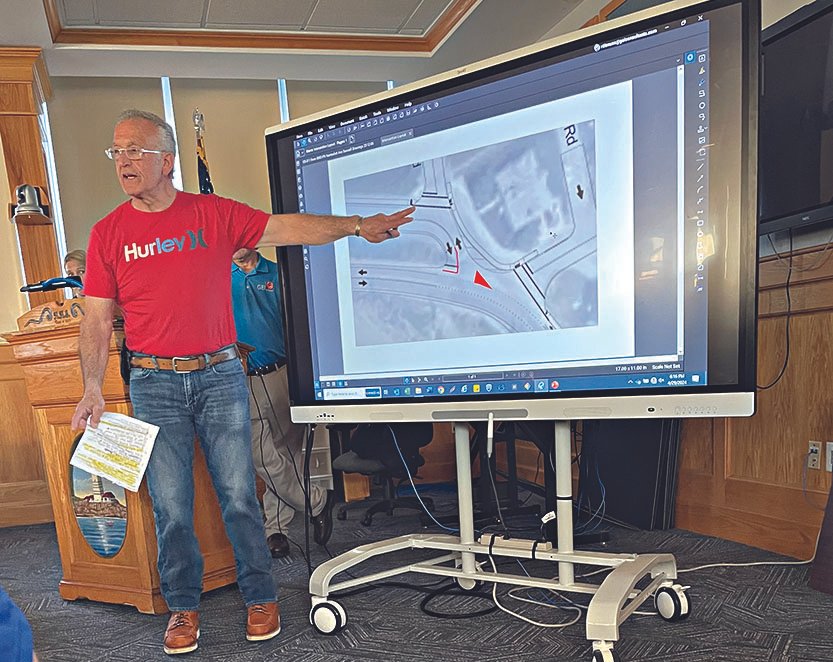After years and years of Accessory Dwelling Unit/accessory apartment zoning bylaw drafts, Town of Hull officials have agreed on a favorable ADU bylaw.
Advocates and supporters have always demonstrated the benefits of expanding property rights for the owner-occupants of the single-family homes that need to include an ADU, but it’s been a challenge to clearly demonstrate the value and benefits to the town in general.
This year is different because the clear benefit to the town is to protect our local control over zoning decisions.
Please support the Accessory Dwelling Unit zoning bylaw, Article 29, at town meeting.
The town planner has drafted an improved ADUs-by-special-permit-bylaw article through the collaborative efforts of the planning board, the zoning bylaw committee, and the zoning board, which also has the support of the advisory board and the affordable housing committee, as well as many informed residents concerned about their own future ability to remain in our community and age in place in their current homes.
The successful collaborative work was completed, as requested, in response to the 2023 town meeting votes. The purpose for the ADU article is to provide additional housing choices to those who would benefit from participating in the ADU process. The time to pass the ADU bylaw is now, because it has become critically important for Hull citizens to protect our local control over zoning decisions.
The Commonwealth of Massachusetts Legislature is in the process of finalizing the $4 billion housing bond bill revisions to the Massachusetts General Laws Chapter 40A Zoning Enabling Act, which will mandate ADUs as-of-right in all cities and towns, with no requirements that the single-family homes remain owner-occupied, and no limit to the number of ADUs permitted.
The Hull Planning Board’s ADUs-by-special-permit-bylaw will require that the property remains an owner-occupied, single-family home with an ADU that the owner can live in or rent to a tenant of their choosing with whom to share their home.
Hull will limit the number of ADUs approved through the special permit hearing process to 10 per year, with a cap of 100 in total. Hull will require additional parking for ADUs. Hull will prohibit ADUs from becoming short-term rentals, with the condition that minimum lease terms shall be six months, which is the legal threshold to ensure that tenants are Hull residents who can register to vote and pay taxes.
Please support local control of ADU permits and protect Hull’s single-family residential districts from the negative impacts of the potential for unlimited ADUs with absentee landlords and corporate ownership, as proposed in the Commonwealth’s housing bond bill.
Half of the cities and towns in the Commonwealth of Massachusetts have their own ADU bylaws with local control (including Hingham, Cohasset, and Scituate), and they’re proposing amendments to the housing bond bill that will protect the current requirements in existing local ADU bylaws. If Hull passes this ADU bylaw prior to the enactment of the new state law, we will also be in a much better place to enforce our own local requirements that will ensure a fair public hearing process, on a case-by-case basis, with notice to abutters, which will protect the character of our neighborhoods.
Sincerely, Patrick Finn
Police station tour provided an eye-opening perspective on building conditions…
To the Editor:
Hull residents must vote “yes” on Article 21 at town meeting to approve the borrowing of a sum of money to pay for the costs of a feasibility study for a new combined public safety facility. Similarly, but at a later time in the hopefully near future, Hull residents must also vote to approve the borrowing of a sum of money to build a brand-new combined public safety facility.
A picture is worth a thousand words. This layperson citizen had never seen the interior of Hull’s – or any other – police department headquarters until I attended the HPD’s open house tours on Saturday, April 27. Enlightened to see in-person what no words can aptly describe, I am shocked, horrified, and quite frankly disgusted at the despicable building conditions in which Hull’s men and women in blue conduct their daily operations. Dangerous, deteriorated, damp, dark, dingy, and deplorable are terms that approach an accurate description of the following small sampling of pervasive, wholly non-compliant, severely outdated realities I witnessed and recorded in my pages of copious notes taken during the guided tour:
• Exposed, decaying hot water pipes – everywhere – are wrapped to “cover” the asbestos.
• Lead paint and crackling lead paint chips – everywhere – from deteriorating walls.
• Poor air quality due to lack of ventilation, air circulation, and exhaust system.
• Rotted [bathroom] floors, non-working sinks, and pervasive stench from mold/sewage.
• No windows in all basement offices.
• Poor/minimal (dim) lighting.
• Non-compliant detention cells, posing tremendous safety and security risks to police officers and detainees alike.
• Non-working/non-usable elevator going upstairs to town hall.
• Singular stairway going up to town hall has treads that are so old and too narrow that an average person’s small foot (mine!) cannot fit, leading to people falling on these stairs.
• Deteriorated stairs, including carpeting, going up to the women’s cramped locker/shower room.
• Water-damaged ceiling panels falling down – everywhere.
• Predictable interior flooding (two-inch minimum) of the rear storage room leading into the IT room. Required service calls every time it rains.
• No security for officers at the custody entrance booking desk and tiny interview room.
• Two-inch drop-off into every office from the connecting hallway: Watch your step!
• Squad room (kitchen, bathroom, and men’s locker room) are all crammed into one room (each should be a separate entity).
• Animal control “office” is located at the top of the staircase leading into town hall. This make-do “office” – at most 4.5 feet wide – is situated where the officer literally inhales all the toxic exhaust fumes from downstairs.
• No railings and one very dim light bulb on the narrow, old stairs to the boiler room housing the two boilers that heat town hall. The deteriorated floors covered with fluids and filled with holes – some huge! – are dangerously unsafe to walk on. One of the two severely corroded burners chronically leaks, dripping fluid everywhere. Boilers routinely require repairs, service calls twice a week on a good week, thereby necessitating all town hall offices’ reliance on electric space heaters.
Last week, the select board unanimously approved the town manager’s signing of a memorandum of agreement between the school committee and the Town of Hull that will allow town offices to move into the Memorial School once the school consolidation plan is complete in the fall of 2024. After the town offices have vacated town hall and transitioned into the Memorial School, then the Hull Police Department, which can neither afford to
remove nor replace the near-death-on-life-support oil burners that miraculously continue (but not for long!) heating the entire town hall building, will be left to fend for themselves in that decrepit building. Even if the heating system does continue (unreliably! at best) to function, nobody should ever be working in the dangerously unsafe, unhealthy, archaic, cramped conditions that our law enforcement officials have been forced to endure at their own peril for far too long. Hull’s first responders always have our backs, putting the public first, before and above themselves. The time is long overdue that we, the taxpayers of Hull, have the backs of our town’s first responders, putting them first at the very top of the list of our capital improvement projects.
Vote “yes” at town meeting on Article 21 for the feasibility study, and when the time comes – hopefully soon! – vote “yes” to borrow the money needed to build a brand new, state-of-the-art, public safety facility to house the Hull police and fire departments.
Polly Rowe
Proposing an alternate solution to land takings on town meeting warrant…
To the Editor:
We are writing to voice our concerns about the economic and land ownership impact that town meeting warrant Article 33 will have on Hull and its residents. Although Article 33 addresses eminent domain takings of three specific properties, its impact, if adopted, will impose a significant financial burden on the town and give the town implied approval to continue this course of action with other properties.
In one of the cases addressed by Article 33, the town seeks approval to take privately owned property based on the town’s contention that the owner’s use of the land contributes to flooding and destruction of the dune along North Nantasket Beach. This is not supported by the opinions of wetlands experts, nor the history and projection of sea level rise, storm flooding, and damage in the town. In fact, in this case, the homeowners have invested considerable time and money to demonstrate that the town’s concerns can be addressed, at the homeowner’s expense, by measures which will, in fact, improve flood and dune resiliency. The town rejected this proposal and then litigated at considerable expense to the taxpayers. Based on the town’s refusal, the homeowners presented their case to the Massachusetts Department of Environmental Protection, which agreed that their proposal addressed the town’s concerns.
Nonetheless, the town still seeks to take the owners’ land.
In cases like these, where a city/town takes privately owned property, it is required by law that the owners be compensated in an amount equal to the fair value of the land. This amount may be significant and is not known at time of the taking. The process for determining this compensation is often time-consuming and expensive for both the town and the owner.
Article 33 presents three cases where the town will be required to pay just compensation to the owners. Instead of making such takings, saddling the town with unknown financial obligations, we urge the town to resolve these issues with owners in a way that will address both the town’s concerns about protecting against flooding, while at the same time allowing homeowners to continue to own their land and commit to being good stewards for the benefit of the town and its citizens.
Respectfully,
Donna J. Larson, Judith Izenberg, Amy Abrams. Eileen Weinberg, Ric and Kathy Callahan, Shelia Weinberg, Casey Callahan, Charles Shaffer, Steve and Beth Currie, Vasilia and Atha Mitropoulos, Nowell Bloomenthal, Debra de Bastos Cathy Bilodeau, Ken Kansky, Gail Kansky, Bernard Kansky, Larry and Gail Handler, Nancy Bilodeau, Nancy Martens, Bart and Christie O’Connor
Changes to railroad bed access are off track, according to neighbors…
To the Editor:
If it ain’t broke, don’t fix it. Article 37, a directive to keep the railroad bed from XYZ to L Streets open all year-round to vehicular traffic, is not only unnecessary, but also misguided. For more than 70 years, the use of barriers on the railroad bed during the summer when the population swells has proven to be a safe and protected means for families accessing the beach.
Is there an advantage to keeping the railroad bed open during the summer? No, no!
• It seems an emergency situation would be the only reason to prompt this proposal. Fortunately, emergencies are not very common, and access to any property can easily be achieved by fire or police. Access out of town should not depend on this narrow strip of land.
• If the railroad bed were open all summer, what we see during the winter would continue and be quite hazardous – operators of commercial vehicles like trash trucks, Amazon, FedEx, UPS, GrubHub, etc. drive without a sense that people live in the neighborhood. The occasional “hot shot” can be seen flying down the railroad bed with no concern for anyone who might possibly be nearby.
• Residents themselves do not drive the entire railroad bed.
Are there disadvantages to leaving the railroad bed open during the summer month. Yes!
• First, the railroad bed was not intended to be a road. It was designed to support a train and, as such, is so narrow that it has been appropriated by abutters in the rest of the town. Its narrowness prevents it from being a viable road in the warmer months. Pedestrian traffic would be seriously jeopardized, and parking would be negatively impacted.
• Second, and most important, is safety.
- During the warmer months the pedestrian traffic is at least 20 times what it is in the winter months, not only during the daytime, but early mornings and evenings as people enjoy the beauty and serenity of the area – walking, running, cycling, pushing carriages, etc.
- Little ones often run ahead of the parents going to and from the beach. Having the poles in place prevents a terrible accident; the obstructed railroad bed provides a safe buffer for families.
- It also provides a safe area for kids to wander to various establishments for ice cream, snacks, and food.
- The Hull summer recreation camp brings scores of kids to the beach for play as well as swim lessons.
- The Seaside Montessori walks the children to the beach for activities once the weather gets warm.
- Parking areas at L, N and XYZ draw many families with many kids. Having traffic flow along the railroad bed would create a serious hazard. Hull residents drive up the alphabet streets and drop off kids, beach equipment, etc. To have through traffic during the summer would create quite a problem.
• Third, parking for summer residents is another huge consideration. Residents who live along the beach have little area to park except when the road is blocked off. Fortunately, neighbors have come to accommodate each other’s needs with the poles providing space for cars.
• Fourth, Article 37 describes a rigid plan that does not take into consideration the reality of the summer population, the flow of traffic, signage, etc. and makes no provision for the possibility of using barriers that could be moved if necessary.
Every problem should have a solution that is agreeable to most people. We see the need for temporary barriers, like the telephone poles or other types of objects, which can be moved, if need be, as a viable alternative to any petition designed to give free access to vehicular traffic on the railroad bed during the summer months.
At this time, we are hoping town residents will vote “no” to Article 37. There’s absolutely no reason to change something that has worked for generations.
Mary Jo Fleming
Like what you’re reading? Stay informed with a Hull Times subscription by clicking here.
Do you have an opinion on this issue? Click here to write a Letter to the Editor.

























